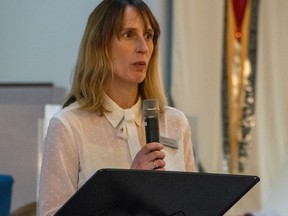Survey was completed by the Network for Economic and Social Trends at London’s Western University

A new United Way Perth-Huron report suggests there are higher rates of discrimination in this region than other jurisdictions in Southwestern Ontario.
Advertisement 2
Article content
Part of the United Way’s Quality of Life report, these rates were compiled through a survey completed by the Network for Economic and Social Trends (NEST) at London’s Western University that compared nine regions, including Sarnia-Lambton, St. Thomas-Elgin, Oxford County, Wellington County, Huron-Perth, Hamilton, London-Middlesex, Niagara and Guelph.
Article content
The report indicated Indigenous peoples are the most likely to experience discrimination in Perth and Huron, followed by immigrants and visible minorities. In the three years before the 2021 survey, 81 per cent of Indigenous people, 68 per cent of immigrants and visible minorities, and 49 per cent of white people who are not immigrants reported experiencing discrimination.
Advertisement 3
Article content
When looking at immigrants and visible minorities, Black people, at 86 per cent, reported experiencing discrimination more than other ethnicities.
“For comparison, London-Middlesex conducted the exact same survey during the same time frame, and found that 62 per cent of Indigenous people, and 37 per cent of immigrants and visible minorities experienced discrimination,” said Kristin Crane, the local United Way’s director of social research and planning, during a Jan. 8 presentation to North Perth council.
For immigrants and visible minorities, discrimination was often experienced when applying for a job or promotion (43 per cent), at work (42 per cent), in a store, bank or restaurant (38 per cent), and while using public areas such as parks (35 per cent).
Advertisement 4
Article content
“Amongst the nine regions in Southwestern Ontario that conducted the same survey, Perth-Huron had the most frequent rates of discrimination,” Crane said.
For Indigenous people in Huron and Perth counties, discrimination was experienced while using libraries, community centers and arenas (61 per cent), when attending school or classes (61 per cent), while using public areas such as parks (60 per cent), and when participating in clubs, meetings or organizations (55 per cent).
“In terms of specific types of discrimination experienced, inappropriate jokes and derogatory language were most frequently mentioned by all three groups, followed by verbal abuse and threat,” the United Way report states. “These findings suggest anti-discrimination initiatives in Huron-Perth would do well to specifically target these forms of discrimination, especially since inappropriate jokes and derogatory language might be discounted as trivial.”
Advertisement 5
Article content
Factors increasing the likelihood of discrimination, the report noted, included having a lower level of education or being recent residents of the region. Age also played a factor, with residents 18 to 35 reporting more frequent incidents of discrimination.
An academic paper outlining the data collected by NEST was published in the Canadian Review of Sociology on Jan. 31, 2023. Crane also cited a 2021 report on discrimination that was conducted by the Huron County Immigration Partnership, which looked solely at the Huron-Perth region.
The report noted that Perth-Huron’s combined population in 2021 was 143,150, including 81,565 Perth County residents and 61,366 Huron County residents. Of that population, 5.5 per cent in Perth County identified as racialized while two per cent in Huron County identified as racialized.
Advertisement 6
Article content
“The term ‘racialized’ refers to people who do not identify as white or Caucasian,” Crane said.
The largest racialized population in Perth County is South Asian while, in Huron County, the largest racialized population is Black. The 2021 census also indicated Perth County is home to 7,310 immigrants and Huron County is home to 4,200 immigrants.
In the face of these rates of racial discrimination, as well as the growing number of newcomers, the United Way report emphasized that diversity in a community offers better outcomes for all residents.
“When we reflect diversity, such as race, gender, age, ethnicity, socioeconomic status, culture, and (dis)ability in our communities and structures, we’re more likely to have more engagement and better outcomes for all,” the report stated. “Although there is plenty of variation among residents of Perth and Huron, our region is less diverse than other parts of our province, something we share with other rural regions.”
The Local Journalism Initiative is funded by the Government of Canada.
Article content